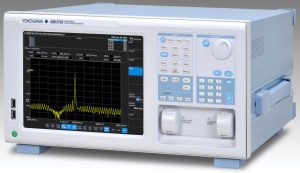
“AQ6375E and AQ6376E are the only grating based OSAs covering SWIR [short wave infra-red] over 2μm and MWIR [mid-wave] over 3μm with world class optical performance,” claimed the company, adding that they have “extreme optical precision to aid development of measurement lasers.”
There are two basic models and two variants:
- AQ6375E Standard: 1,200 – 2,400nm
- AQ6375E Limited: 1,200 – 2,400nm (reduced wavelength resolution)
- AQ6375E Extended: 1,000 – 2,500nm
- AQ6376E Standard: 1,500 – 3,400nm
“The free space optical input offers single-mode fibre for the SWIR and MWIR regions, and MMF up to 400µm on the same analyser,” said Yokogawa. “The small variation in insertion loss at the input connector increases measurement repeatability, while the lack of physical contact with the connecting fibres ensures they avoid damage.”
There is a built-in calibration source for optical alignment and wavelength calibration, and the internal monochromator can be purged, for example with nitrogen, against water vapour and carbon dioxide absorption in SWIR and MWIR – the purge gas connector is on the back panel.
Except the AQ6375E Limited, high-order diffracted light produced by the monochromator is compensated by a built-in cut filter.
Built-in analysis functions to include: DFB-LD, FP-LD, LED, spectral width (peak/notch), SMSR, optical power, WDM (OSNR), EDFA (gain and NF), filter (peak/bottom) and WDM filter (peak/bottom).
As well as keys for sweep control (auto/single/repeat/stop), resolution setting and sensitivity setting on the front panel, the 10.4inch screens include capacitive multi-touch for instrument control.
For production testing of particular devices, the analyser can be locked (into ‘APP mode’) to perform a specific measurement. Units come pre-installed with several basic tests including WDM, DFB-LD, FP-LD – and there is an associated wizard to ease set-up.
APP mode supports a fibre inspection probe, allowing users to visualise the quality of the fibre connector surface.
A LAN port is provided to access files stored in internal memory and for firmware updates, and USB ports are there for mouse, keyboard and USB storage (data and screenshots can be saved to internal memory or USB storage to create test reports.
